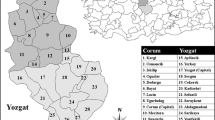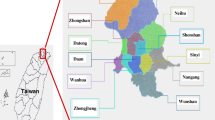Abstract
Ticks (Acari: Ixodida) are an important group of ectoparasites of vertebrates. Most species are known vectors of diseases including Lyme disease, Q fever, and Crimean–Congo hemorrhagic fever. A 3-year research was conducted in Antalya, Turkey, to determine tick species composition, seasonal abundance, and spatial distribution. The study was carried out in five districts (Aksu, Dosemealtı, Kepez, Konyaaltı, and Muratpasa) of Antalya Metropolitan Municipality area in Turkey, between May 2010 and May 2013, where 1393 tick specimens were collected from domestic and wild animals (cattle, goats, sheep, hedgehogs, tortoises, dogs, cats, chickens) and from the environment. The collected ticks were preserved in 70 % alcohol and then were identified. Five genus and eight hard and soft tick species were identified, including Argas persicus, Rhipicephalus annulatus, R. sanguineus, R. turanicus, Hyalomma aegyptium, H. marginatum, Haemaphysalis parva, and Dermacentor niveus. Rhipicephalus sanguineus, R. turanicus, and H. aegyptium were the most common tick species in Antalya city. Rhipicephalus turanicus and R. sanguineus were the most abundant tick species infesting dogs in the city. The hosts of H. aegyptium are primarily tortoises in Antalya. The results of this research will contribute to establishing appropriate measures to control tick infestations on animals and humans and their environment in the city of Antalya.

Similar content being viewed by others
References
Anderson JF, Magnarelli LA (2008) Biology of ticks. Infect Dis Clin N Am 22:195–215. doi:10.1016/j.idc.2007.12.006
Aydın L (1994) Güney Marmara Bölgesi ruminantlarında görülen kene türleri ve yayılışları, Dissertation, University of Uludag
Aydın L (2000) Distribution and species of ticks on ruminants in the southern Marmara region. Acta Parasitol Turc 24:194–200
Aydın L, Bakırcı S (2007) Geographical distribution of ticks in Turkey. Parasitol Res 101:163–166. doi:10.1007/s00436-007-0694-5
Aysul N, Kar S, Yılmazer N et al (2010) Prevalence of Hyalomma aegyptium (Lineaus, 1758) in tortoises (Testudo graeca) in Thrace. Pendik Vet Mikrobiyol Derg 37:53–56
Barker SC, Murrell A (2004) Systematics and evolution of ticks with a list of valid genus and species names. Parasitology 129:15–36. doi:10.1017/S0031182004005207
Bursali A, Tekin S, Keskin A et al (2011) Species diversity of ixodid ticks feeding on humans in Amasya, Turkey: seasonal abundance and presence of Crimean-Congo hemorrhagic fever virus. J Med Entomol 48:85–93. doi:10.1603/ME10034
Bursali A, Keskin A, Tekin S (2012) A review of the ticks (Acari: Ixodida) of Turkey: species diversity, hosts and geographical distribution. Exp Appl Acarol 57:91–104. doi:10.1007/s10493-012-9530-4
Dantas-Torres F (2008) The brown dog tick, Rhipicephalus sanguineus (Latreille, 1806) (Acari: Ixodidae): from taxonomy to control. Vet Parasitol 152:173–185. doi:10.1016/j.vetpar.2007.12.030
Dantas-Torres F (2010) Biology and ecology of the brown dog tick, Rhipicephalus sanguineus. Parasit Vectors 3:26. doi:10.1186/1756-3305-3-26
Durrani AZ, Shakoori AR, Kamal N (2008) Bionomics of Hyalomma ticks in three districts of Punjab, Pakistan. J Anim Plant Sci 18:20–23
Gargili A, Kar S, Yilmazer N et al (2010) Evaluation of ticks biting humans in Thrace Province, Turkey. Kafkas Univ Vet Fak Derg 16:141–146. doi:10.9775/kvfd.2009.2555
Gazyagci S, Asan N, Demirbas Y (2010) A common tortoise tick, Hyalomma aegyptium Linne 1758 (Acari: Ixodidae), identified on eastern hedgehog (Erinaceus concolor Martin 1838) in Central Anatolia. Turk J Vet Anim Sci 34:211–213. doi:10.3906/vet-0808-21
Goz Y, Yılmaz AB, Aydin A, Dicle Y (2014) Ticks and fleas infestation on east hedgehogs (Erinaceus concolor) in Van Province, Eastern Region of Turkey. J Arth Born Dis
Guglielmone AA, Robbins RG, Apanaskevich DA et al (2010) The Argasidae, Ixodidae and Nuttalliellidae (Acari: Ixodida) of the world: a list of valid species names. Zootaxa 2528:1–28. doi:10.1023/A:1025381712339
Hekimoglu O, Ozer N, Ergunay K, Ozkul A (2012) Species distribution and detection of Crimean-Congo hemorrhagic fever virus (CCHFV) in field-collected ticks in Ankara Province, Central Anatolia, Turkey. Exp Appl Acarol 56:75–84. doi:10.1007/s10493-011-9492-y
Hillyard PD (1996) Ticks of north-west Europe: keys and notes for identification of the species. Shrewsbury, England
Hoogstraal H (1956) African Ixodidae volume I ticks of the Sudan. Cairo, Egypt
Ince Y, Yasa C, Metin M et al (2014) Crimean-Congo hemorrhagic fever infections reported by ProMED. Int J Infect Dis 26:44–46. doi:10.1016/j.ijid.2014.04.005
Jongejan F, Uılenberg G (2004) The global importance of ticks. Parasitology 129:3–14. doi:10.1017/S0031182004005967
Karaer Z, Guven E, Nalbantoglu S et al (2011) Ticks on humans in Ankara, Turkey. Exp Appl Acarol 54:85–91. doi:10.1007/s10493-010-9417-1
Koc-San D, San BT, Bakis V et al (2013) Multi-criteria decision analysis integrated with GIS and remote sensing for astronomical observatory site selection in Antalya province, Turkey. Adv Space Res 52:39–51. doi:10.1016/j.asr.2013.03.001
Mehravaran A, Moradi M, Telmadarraiy Z et al (2013) Molecular detection of Crimean-Congo haemorrhagic fever (CCHF) virus in ticks from southeastern Iran. Ticks Tick Borne Dis 4:35–38. doi:10.1016/j.ttbdis.2012.06.006
Mertens M, Schmidt K, Ozkul A, Groschup MH (2013) The impact of Crimean-Congo hemorrhagic fever virus on public health. Antivir Res 98:248–260. doi:10.1016/j.antiviral.2013.02.007
Mura A, Masala G, Tola S et al (2008) First direct detection of rickettsial pathogens and a new rickettsia, “Candidatus Rickettsia barbariae”, in ticks from Sardinia, Italy. Clin Microbiol Infect 14:1028–1033. doi:10.1111/j.1469-0691.2008.02082.x
Orkun O, Karaer Z, Cakmak A, Nalbantoğlu S (2014) Identification of tick-borne pathogens in ticks feeding on humans in Turkey. PLoS Negl Trop Dis 8:3067. doi:10.1371/journal.pntd.0003067
Ortaçeşme V, Atik M (2012) Urban and regional landscapes in Antalya. Le: Notre Landscape Forum 18th–21st April 2012 Antalya, Turkey
Over L, Inceboz T, Yapar N et al (2012) Investigation of the cases presenting to Dokuz Eylül University Hospital with tick bites. Turk Parazitol Derg 36:75–81. doi:10.5152/tpd.2012.19
Sengil AZ, Akkaya H, Gonenc M et al (2011) Species composition and monthly distribution of mosquito (culicidae) larvae in the Istanbul metropolitan area, Turkey. Int J Biol Med 2:415–424
Tavassoli E, Rahimi-Asiabi N, Tavassoli M (2007) Hyalomma aegyptium on spur-thighed tortoise (Testudo graeca) in Urmia region, West Azerbaijan, Iran. Iran J Parasitol 2:40–47. doi:10.1016/0035-9203(50)90050-2
Tuncer D, Mutlu G, Karaer Z et al (2004) Seasonal occurrence of ticks on goats and Borrelia burgdorferi influence in Ixodes ricinus in Antalya region. Turk Parazitol Derg 28:158–160
Vatansever Z, Gargili A, Aysul NS et al (2008) Ticks biting humans in the urban area of Istanbul. Parasitol Res 102:551–553. doi:10.1007/s00436-007-0809-z
Vitale G, Mansueto S, Rolain JM, Raoult D (2006) Rickettsia massiliae human isolation. Emerg Infect Dis 12:174–175. doi:10.3201/eid1201.050850
Walker AR, Bouattour A, Camicas J-L et al (2003) Ticks of domestic animal in Africa: a guide to identification of species. Edinburgh, United Kingdom
Acknowledgment
The authors are grateful to the Scientific Projects Administration Unit of Akdeniz University (Antalya, Turkey) for financial support (Project Number: 2011.02.0121.046). The authors would like to thank Res. Asst. Emre OZ and the municipality pest control workers for assistance during the field studies.
Conflict of interest
We certify that there is no conflict of interest regarding the material discussed in the manuscript.
Author information
Authors and Affiliations
Corresponding author
Rights and permissions
About this article
Cite this article
Koc, S., Aydın, L. & Cetin, H. Tick species (Acari: Ixodida) in Antalya City, Turkey: species diversity and seasonal activity. Parasitol Res 114, 2581–2586 (2015). https://doi.org/10.1007/s00436-015-4462-7
Received:
Accepted:
Published:
Issue Date:
DOI: https://doi.org/10.1007/s00436-015-4462-7




